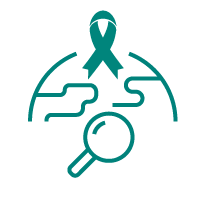WHAT IS HPV?¹
HPV stands for Human Papillomavirus, a group of commonly occurring viruses known for causing infections in the reproductive tract.
It is common for most adults to contract HPV at some point in their lives, with some experiencing multiple infections. Most HPV cases resolve on their own within a few months, and approximately 90% clear within 2 years.
Adults of reproductive age are at the highest risk of getting HPV infections. While many types of HPV are harmless, there are many high risk types that can cause certain cancers in women, such as those that may persist and progress into cervical cancer.
HPV BY THE NUMBERS
Did you know?

As of 2011, about 660,000,000 people worldwide are infected with HPV.²

85% of women of reproductive age may get the HPV infection at some stage in their life.³

~1 in 22 cancers worldwide were caused by HPV.⁴,⁵

Each year, there are approximately 12,000 cases of cervical cancer leading to over 4,000 deaths in women.7
HPV-RELATED CANCERS
HPV is the leading cause of several types of cancers4,7-9
The HPV infection can lead to*,**

90% of high-grade
cervical precancers10

75% of low-grade
cervical lesions10
*Estimates based on incidence data and US Census World population figures.
**Not all cervical precancers and lesions are caused by HPV.
How an HPV infection can lead to cervical cancers¹
Most HPV infections clear up on their own, and most precancerous lesions resolve spontaneously. However, women are still at risk of HPV infection becoming chronic and progressing to invasive cervical cancer.
It takes 15-20 years for cervical cancer to develop in women with normal immune systems, whereas it can take only 5-10 years to develop in women with weakened immune systems, such as those with untreated human immunodeficiency virus (HIV) infections.
SIGNS AND SYMPTOMS
HPV has no signs or symptoms.11
Here is how women might find out if they are infected

Most people with HPV do not know they are infected and never develop symptoms and health problems from it.

Some people find out they have HPV when they develop warts.

Women may find out they have HPV when they get a positive Pap test result (during cervical cancer screening).

Others may only find out once they’ve developed more serious problems from HPV, such as cancers.
HOW IT SPREADS11-13

HPV can be passed on to others even when an infected person has no signs and symptoms.

Even married couples can get HPV as one or both spouses may have already had it while being asymptomatic.
